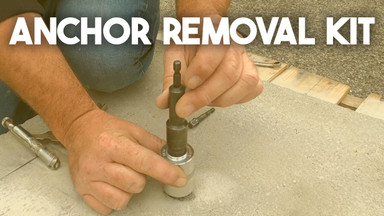How to Use a Brass Anchor Pulling Tool Kit (Loop-Loc)
Published by Matt Fichera on 10/05/2020
Posted in: Pool Winterization
From our previous video and blog, we’ve illustrated and shown how to try and use a garden hose to loosen brass anchor that are stuck. We’ve also showed how to drill a new hole in your pool deck for a new brass anchor. If the brass anchor remains stuck, stripped, and/or just spins in place, there are a couple brass anchor removal kits available that can help remove the stuck anchor. The solution is to drill the anchor screw out of its stuck position. Drill down the center making sure that it’s long enough for the tap tool to reach through. At this point it’s opened up enough for you to run your tap into it.
Place your tap tool into the newly drilled hole on the stuck anchor. The Loop Loc Brass Anchor Pulling Kit comes with a very handy tool that has a wrench slot in order to hook right on top of the tap when creating your new threads. You’ll want to turn it back and forth quite a bit using the wrench tool. This step in the process is not a speedy one and can take time to cut the threads nicely so that you don’t bunch up the filings you’re cutting.
Keep in mind that all anchors on safety covers are brass regardless of the manufacturer. During this process you are going to maneuver the tap down just over half of its length into the anchor. Sometimes you may need something to grasp the tapping tool to help it go in a bit further. For our demonstration we’re using vice grips because there isn’t a small enough wrench for the top of the tool. You will reach a point where it is bound and doesn’t want to move any further, this is when you’ll stop and back the tap all of the way out by spinning it counter-clockwise. Once the tap is removed you can see inside of the anchor that new threads were in fact cut.
Some additional advice is to not over crank using the tapping tool because you will pull the threads right out. If you take a look you can see the threads lower in the anchor but the top is now stripped out. The inside has been both weakened too much and made too wide where you can’t grab properly.
This particular tool has a hardened steel stud with a nut part that has legs on it so that our tool can properly grab it. Before attaching this, make sure that the silver sleeve is also on. The inside of that same wrench tool has an opening which is slotted that fits onto the legs of the nut. The top of the tool is a quarter inch hex head. Either a quarter inch socket or a quarter inch wrench can be used in this case but neither of them are included in the kit. A power drill can also be used or If you do not have the proper wrench, vice grips can also be used. At this point you can grab the top and twist until it lifts the anchor up. A couple of taps on the sleeve with a hammer will also help to loosen the anchor up, especially along its top threads. You’ll get to a point where you can spin it the rest of the way by hand and remove the anchor from the cement. Detach everything connected by spinning counter-clockwise.
Make sure not to catch the sleeve on the top of the anchor because it will hold the anchor in place and work against what you are trying to accomplish. Make sure that the sleeve is centered properly over the anchor upon placing it. The sleeve can be a bit wobbly making it a good candidate to catch especially against certain patio types like aggregate or if there is a chip near the anchor.
The Loop Loc Brass Anchor Pulling Kit that's featured comes with the following items:
- -Wingmaster Tap 5-16
- -Wingmaster Anchor Extractor
- -Wingmaster Hardened Stud
- -Wingmaster Castle Nut
- -Wingmaster Castle Nut Driver
This kit is available for purchase on our site at the link located: here.
We also have many of the items featured in this video available for sale individually including the tamping tool. Please be advised that this kit does not come with a drill bit. The proper size is a quarter inch. Our team is happy to answer any questions.We also have a GLI Brass Anchor Pulling Kit available for purchase: here
Watch our Video on this as well:



